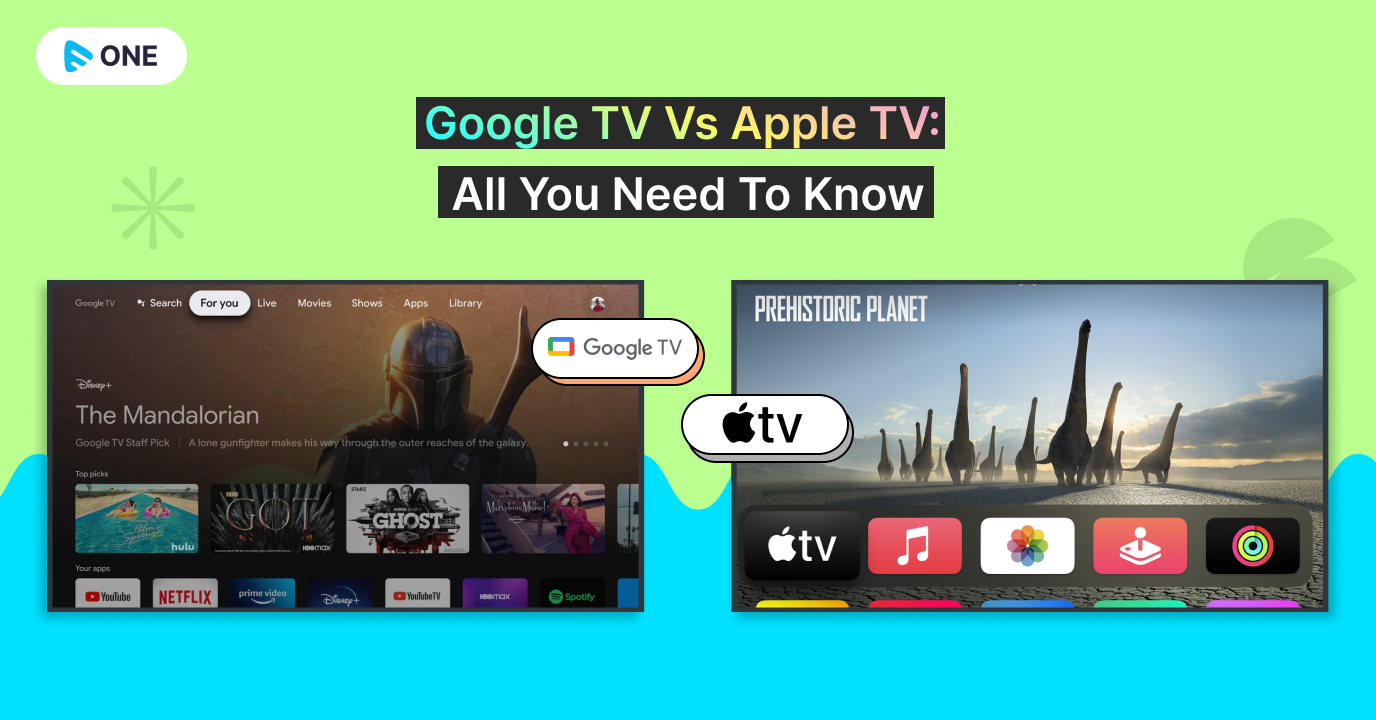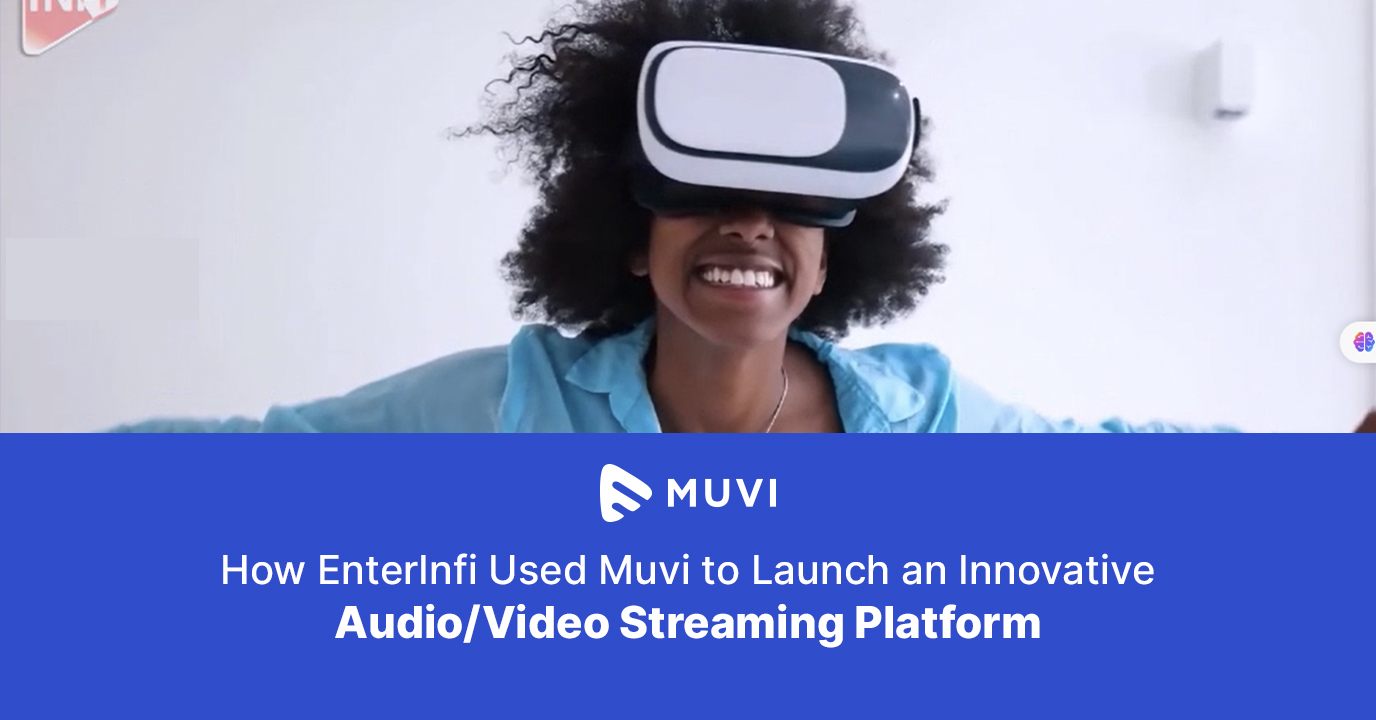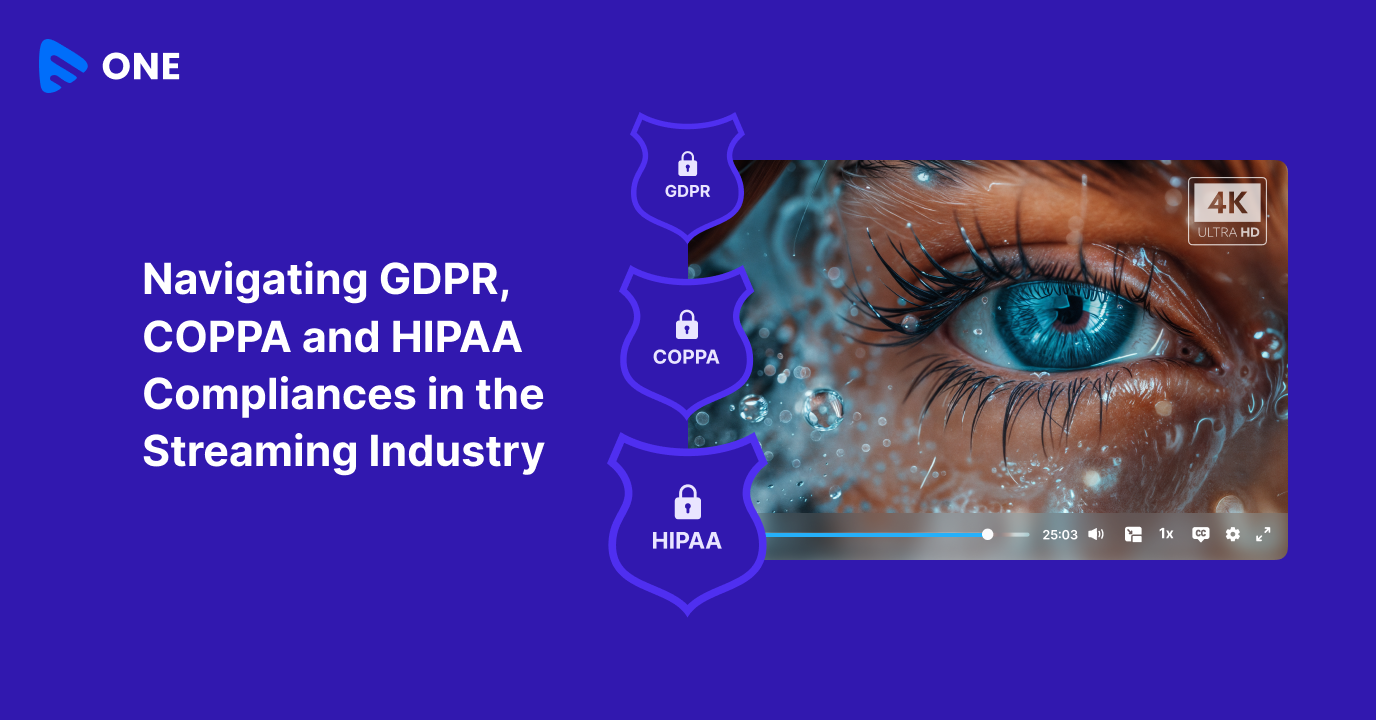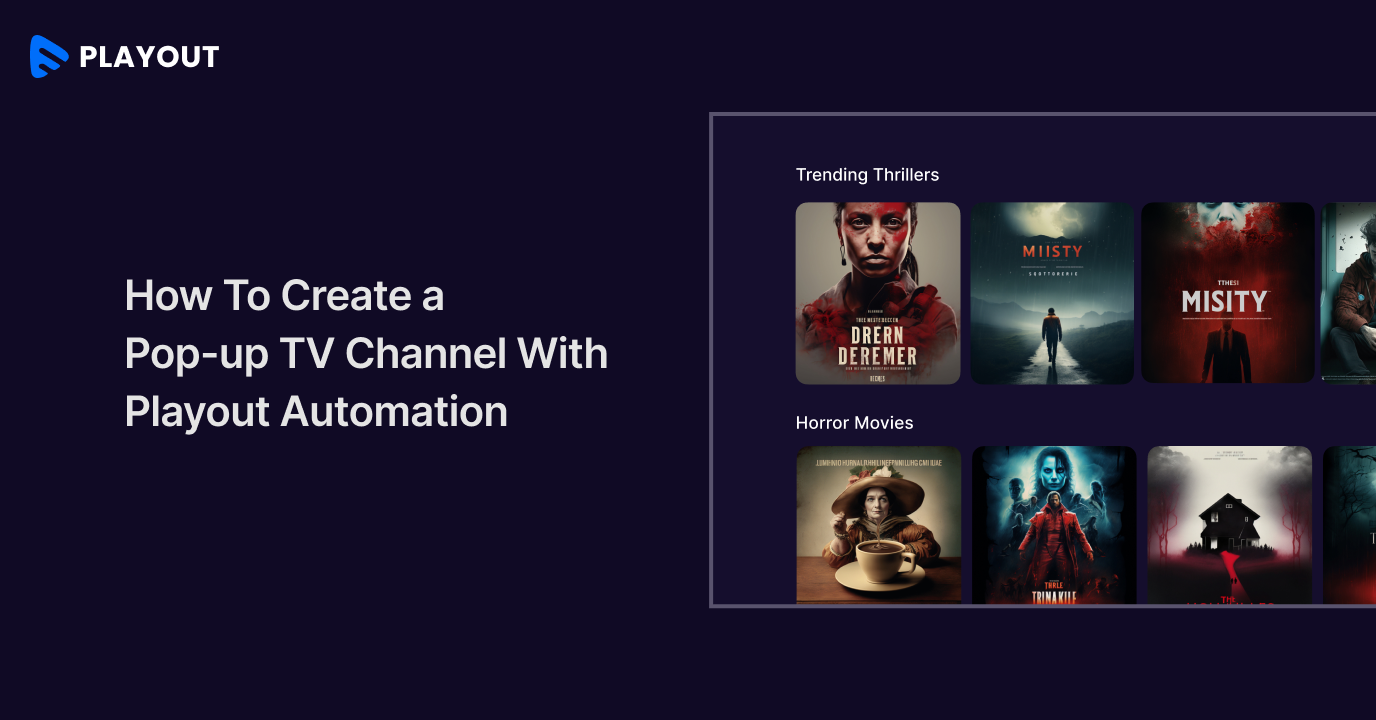Are you struggling to choose between Google TV vs Apple TV to launch your own branded smart TV app?
As the demand for streaming content continues to surge, understanding the distinctions between these two platforms becomes paramount for smart TV app businesses looking to thrive in this competitive landscape.
The choice between Google TV and Apple TV can significantly impact a smart TV app’s success. These platforms offer distinct ecosystems, user experiences, and integration capabilities, making it imperative for app developers to make informed decisions.
By gaining a comprehensive understanding of these factors, you can make strategic choices, tailor their content, and target their audience effectively. In an era where content delivery and user experience play pivotal roles, the right choice can be a game-changer.
And in this blog, we will walk you through all you need to know about Google TV vs Apple TV.
What Is Google TV?
Google TV is a smart television platform developed by Google. It serves as an operating system for smart TVs and streaming devices, enhancing the way users access and consume content on their television screens.
Google TV is designed to provide a unified and user-friendly interface that seamlessly integrates various streaming apps, live TV, and personalized content recommendations.
At its core, Google TV is built upon the Android TV platform, but it introduces several unique features and functionalities. It leverages Google’s extensive search capabilities to help users discover a wide range of content, from movies and TV shows to music and apps. Users can search for content using voice commands, making it a convenient and hands-free experience.
What Is Apple TV?
Apple TV is a digital media player and streaming device developed by Apple Inc. It is designed to deliver a wide range of digital content, including movies, TV shows, music, apps, and games, to a user’s television screen. Apple TV connects to a TV through an HDMI cable and can be controlled using a remote or the Apple TV app on other Apple devices like iPhones and iPads.
One of the primary functions of Apple TV is to provide access to streaming services and platforms like Apple TV+, Netflix, Amazon Prime Video, Disney+, Hulu, and many others. Users can subscribe to and watch content from these services directly on their TV using the Apple TV device.
In addition to streaming services, Apple TV also integrates with the user’s iTunes library, allowing them to purchase or rent movies and TV shows. It serves as a media hub, enabling users to access and organize their digital media content, including music and photos.
Apple TV also supports various apps and games, making it a versatile entertainment and productivity tool. Users can download and install apps from the Apple App Store, transforming their TV into a platform for a wide range of activities beyond video streaming.
Google TV: Overview, History, Potential
Google TV is a sophisticated smart television platform developed by Google, designed to enhance the television-watching experience by providing a unified interface for content discovery and access.
Launched in 2020, Google TV builds upon the foundation of Android TV while introducing several innovative features and functionalities. It serves as an operating system for a range of smart TVs and streaming devices, making it easier for users to discover, access, and enjoy a diverse array of content seamlessly.
Google TV’s evolution can be traced back to its predecessor, Google’s initial attempt at entering the television market with Google TV in 2010. However, the early version faced challenges, including complex interfaces and limited content integration. Despite the initial setbacks, Google persisted and, in 2020, reintroduced Google TV as a refined platform.
The reimagined Google TV integrated many of the lessons learned from the initial launch. It introduced a sleek, user-friendly interface designed to aggregate content from various streaming services, live TV, and apps, effectively eliminating the need for users to switch between multiple applications. This streamlined experience aimed to simplify content discovery and provide more convenience for viewers.
Google TV’s potential lies in its ability to offer an all-encompassing, user-centric television-watching experience. It continues to evolve with ongoing updates and improvements, positioning itself as a strong contender in the smart TV market.
One area of immense potential is its integration with other Google services and products. As Google continues to expand its ecosystem, Google TV can serve as a central hub for accessing Google Photos, Google Drive, and even smart home control through Google Assistant. This potential for integration across various facets of a user’s digital life enhances its value.
Moreover, Google TV’s platform welcomes third-party developers, encouraging the creation of new apps and services that can further enrich the television experience. As the ecosystem expands, we can anticipate more innovative content delivery methods, interactive experiences, and educational tools.
Apple TV: Overview, History, Potential
Apple TV is a groundbreaking digital media player and streaming device developed by Apple Inc. It has redefined the way people access and consume digital content, making it an integral part of the modern home entertainment landscape.
Launched in 2007, Apple TV has evolved over the years, offering users a diverse range of entertainment options, from streaming services and digital rentals to apps and games. This overview delves into the history, key features, and potential of Apple TV.
Apple TV’s history can be traced back to its initial release as a set-top box. Over the years, it has undergone significant transformations, both in hardware and software. Apple’s vision was to bridge the gap between traditional television and digital content by providing a streamlined and user-friendly experience.
In 2015, Apple TV received a major overhaul with the introduction of the fourth generation. This iteration brought the powerful tvOS operating system, a dedicated App Store, and the Siri Remote, which included voice control capabilities.
These enhancements turned Apple TV into a comprehensive entertainment platform that extended beyond content streaming to include interactive apps, games, and even home automation through Apple’s HomeKit.
Apple’s commitment to improving the Apple TV experience continued with the launch of the Apple TV 4K in 2017, which added support for 4K resolution and high dynamic range or HDR content. This upgrade aimed to deliver superior picture quality and elevate the viewing experience to new heights.
The potential of Apple TV lies in its versatility and integration within the broader Apple ecosystem. As Apple continues to innovate and expand its services, Apple TV remains a critical component, offering seamless integration with other Apple devices and services.
One of its most significant potentials is the integration of Apple TV+ – Apple’s streaming service for original content. With a growing library of exclusive shows and movies, Apple TV+ has become a direct competitor in the streaming wars, bolstering Apple TV’s appeal.
Google TV Vs Apple TV: A Comparative Analysis
1. Google TV VS Apple TV: Apps & Ecosystem
Google TV boasts an ecosystem that is deeply integrated with the Google universe. It runs on the Android TV platform, providing access to a wide array of apps available on the Google Play Store.
Here are some Google TV apps from different categories:
Entertainment:
- Netflix
- YouTube
- Amazon Prime Video
- Disney+
- Hulu
Live TV & News:
- YouTube TV
- Sling TV
- CBS News
- Pluto TV
- ABC News
Music Streaming:
- Spotify
- Pandora
- YouTube Music
- Deezer
- Tidal
Sports & Fitness:
- ESPN
- NBA App
- NFL Game Pass
- UFC
- Peloton
Educational & Learning:
- Khan Academy
- Coursera
- TED
- National Geographic
- Duolingo
Gaming:
- Stadia
- GeForce NOW
- Crossy Road
- Asphalt 9: Legends
Kids & Family:
- Disney Junior
- PBS Kids
- Nickelodeon
- Cartoon Network
- BabyFirst TV
To name a few.
Additionally, Google TV is compatible with thousands of Android apps, making it a versatile platform for entertainment and productivity.
Apple TV‘s ecosystem, on the other hand, revolves around the Apple ecosystem, offering seamless integration with other Apple devices and services. The Apple TV App Store provides access to a wide range of apps from diverse categories such as –
Entertainment:
- Netflix
- Hulu
- Amazon Prime Video
- Disney+
- HBO Max
Live TV & News:
- Sling TV
- CBS All Access or, Paramount+
- ESPN
- Bloomberg
- ABC News
Music Streaming:
- Apple Music
- Spotify
- Pandora
- Tidal
- Deezer
Sports & Fitness:
- NBA
- MLB At Bat
- Peloton
- UFC
- NHL
Educational & Learning:
- Khan Academy
- Coursera
- Duolingo
- TED
- National Geographic
Gaming:
- Apple Arcade
- Minecraft
- Alto’s Adventure
- Crossy Road
- Roblox
Kids & Family:
- Disney Junior
- PBS Kids
- Nickelodeon
- LEGO Tower
- Toca Life World
To name a few.
The ecosystem is built on tvOS, Apple’s proprietary operating system for its streaming device.
What sets Apple TV apart is the tight integration with other Apple services. For example, users can share content across their Apple devices through AirPlay, mirror their iOS or macOS screens, and even use their iPhone or Apple Watch as a remote control.
2. Google TV Vs Apple TV: User Interface
Google TV‘s user interface is designed with simplicity and content aggregation in mind. It leverages the Android TV platform to provide a clean and user-friendly interface that centralizes content discovery.
One of the standout features of Google TV is the “For You” tab, where users receive personalized content recommendations based on their viewing history and preferences. This tailored approach enhances content discovery and keeps users engaged.
The home screen showcases content from various streaming services, making it easy for users to access their favorite shows and movies without needing to launch individual apps. The integration of Google Assistant allows for voice searches and commands, making navigation even more intuitive.
Google TV also excels in its content aggregation. It brings together content from different apps and services, allowing users to browse a wide range of options without needing to switch between apps constantly. This simplifies the viewing experience and helps users find the content they want more efficiently.
Apple TV’s user interface centers around a user-friendly experience that integrates seamlessly with the Apple ecosystem. The interface is sleek and easy to navigate, with a focus on content curation and organization.
The Apple TV home screen features the “Up Next” section, which displays content from various streaming services that users have been watching or have in their library. This ensures that users can quickly pick up where they left off in their favorite shows and movies.
The Apple TV app is a central hub for content discovery, bringing together content from different apps and services into one unified interface. Users can easily browse and search for content without needing to switch between apps, providing a more cohesive viewing experience.
Apple TV also prioritizes user privacy and data security. The “Privacy” section in settings allows users to control their data sharing preferences, giving them peace of mind about their personal information.
3. Google TV Vs Apple TV: Voice Assistance
Google TV’s voice assistance is powered by Google Assistant, one of the most widely used virtual assistants globally. With Google Assistant on Google TV, users can perform a wide range of voice-activated tasks and queries.
Users can search for specific movies, TV shows, or genres using natural language commands. For example, saying, “Find action movies” will yield a list of action-packed content.
Google Assistant’s smart home integration lets users control compatible smart devices. Commands like “Turn off the lights” or “Set the thermostat to 72 degrees” can be executed directly from the TV.
Also, users can ask general knowledge questions, check the weather, or get news updates. Google Assistant provides answers and information by accessing its vast database.
Apple TV, on the other hand, employs Siri as its voice assistant, offering similar functionalities to Google Assistant while integrating seamlessly with the broader Apple ecosystem. Siri on Apple TV enables users to search for movies, TV shows, actors, and genres. It understands natural language and delivers relevant results.
Home Control: For users with HomeKit-enabled smart devices, Siri can control lights, thermostats, locks, and more through the TV, ensuring a connected home experience.
Siri can answer general knowledge questions, provide weather updates, and deliver news briefings, leveraging its integration with Apple’s services.
4. Google TV Vs Apple TV: Integration
Google TV is designed to be platform-agnostic, which means it can integrate with a wide range of devices and services, not limited to Google’s own ecosystem.
Google TV seamlessly integrates with Chromecast, allowing users to cast content from their smartphones, tablets, or computers directly to the TV. This feature promotes cross-device compatibility.
It leverages the power of Google Assistant, which is integrated with various devices and services. Users can control smart home devices, check their calendars, and access information across the Google ecosystem.
Also, Google TV excels in content discovery through its cross-platform search capabilities. Users can search for content across multiple apps, making it easier to find what they want to watch.
Apple TV, on the other hand, centers its integration around the Apple ecosystem, creating a seamless and unified experience for users who are already part of the Apple universe:
One of the standout features of Apple TV is AirPlay, which enables users to mirror or cast content from their iOS devices like iPhone, iPad or macOS computers to the TV screen. This integration fosters content sharing and screen mirroring.
Apple TV serves as a hub for controlling HomeKit-enabled smart devices. Users can control lights, locks, thermostats, and more directly from the Apple TV, enhancing home automation.
Furthermore, Apple TV is the gateway to Apple’s streaming service, Apple TV+. Subscribers can access exclusive original content seamlessly from their Apple TV device. It also integrates with the iTunes library, allowing users to purchase or rent movies and TV shows directly through the device.
5. Google TV Vs Apple TV: Learning Curve
Google TV is built upon the Android TV platform, known for its intuitive interface and user-friendliness. Here are some key aspects of its learning curve. If one is already familiar with Android devices like smartphones and tablets, navigating Google TV will likely feel intuitive. The layout and interactions resemble the Android experience.
Google TV’s “For You” tab simplifies content discovery by offering personalized recommendations. Users don’t need to search extensively for content, as it’s presented on the home screen.
Google Assistant’s voice search capabilities make it easy to find and play content using natural language commands. This feature reduces the learning curve for those comfortable with voice interactions.
Google TV offers a wide range of apps, including popular streaming services and Android apps. This diversity may require some exploration, but it also means the users have access to a variety of content and tools.
Apple TV focuses on providing a seamless and cohesive user experience, but it may have a slightly steeper learning curve for those new to the Apple ecosystem: If one is already an Apple user with devices like iPhones, iPads, and Macs, Apple TV’s integration will feel seamless. However, for newcomers to the ecosystem, there might be a learning curve in understanding how different Apple devices work together.
Siri’s voice control can be a powerful tool for navigation and content search on Apple TV. Users need to familiarize themselves with Siri commands to make the most of this feature.
Apple TV’s approach to apps and content curation may require some adjustment. The “Up Next” section keeps track of your recent content, which can be beneficial once you understand how it works.
Features like AirPlay and HomeKit integration offer advanced functionalities but might take time to fully explore and utilize, especially for users new to Apple products.
The Bottom Line
Both Google TV and Apple TV present significant growth opportunities for smart TV app businesses, making it essential for developers to choose the right platform to successfully launch and expand their offerings.
Choosing the right platform to launch and grow smart TV apps is crucial, and platforms like Muvi One offer the necessary tools and support to ensure success. Muvi One is a comprehensive platform that simplifies the development, launch, and management of smart TV apps on both Google TV and Apple TV, as well as other popular platforms.
Muvi One’s features include cross-platform compatibility, app monetization options, content management, analytics, and robust security measures. This allows smart TV app businesses to focus on creating engaging content and user experiences while relying on a trusted platform for technical aspects and scalability.
Muvi One empowers you to launch your branded smart TV app effortlessly, eliminating the need to write a single line of code. Furthermore, Muvi One offers support for over 16+ environments, encompassing Android TV, Fire TV, Apple TV, Roku TV, and many others, ensuring your app’s reach across a wide spectrum of platforms.
Take a 14-day free trial today to explore more.

FAQs
- What are the differences between Google TV and Apple TV?
Google TV is software integrated into various TV brands, while Apple TV is a standalone streaming device. Google TV has broader app support, while Apple TV excels in Apple device integration.
Google TV is a smart TV platform that aggregates content from various streaming services, offers personalized recommendations, and uses Google Assistant for voice control. It runs on compatible smart TVs.
Apple TV is a streaming device and app that connects to your TV. It offers access to Apple’s ecosystem, including streaming content, apps, and games. It’s controlled using an Apple TV remote or other Apple devices.
- Are there any unique features or innovations offered by Google TV or Apple TV?
Google TV integrates Google’s search and Assistant, providing tailored content suggestions. Apple TV emphasizes privacy and offers AirPlay for seamless device connectivity. Both have their strengths in content curation and ecosystem integration.gle
















Add your comment